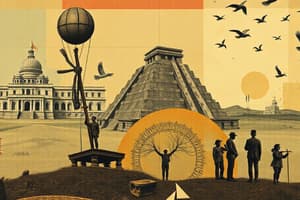Podcast
Questions and Answers
The Tabon Skull fragments, discovered in Palawan, provide evidence supporting which theory regarding the peopling of the Philippines?
The Tabon Skull fragments, discovered in Palawan, provide evidence supporting which theory regarding the peopling of the Philippines?
- The Multiple Homeland Hypothesis, specifically the wave originating from Mainland China.
- The Recent African Origin hypothesis.
- The presence of prehistoric inhabitants as early as the Pleistocene period. (correct)
- The internal development within the Austronesian region, negating external migration.
How did the shift to the New Stone Age influence the social structure and economy of early Filipinos?
How did the shift to the New Stone Age influence the social structure and economy of early Filipinos?
- It led to a decline in population due to increased competition for resources.
- It resulted in a rigid, hierarchical social structure dominated by religious leaders.
- It fostered a nomadic lifestyle centered primarily around hunting megafauna.
- It initiated plant and animal domestication, enabling food production beyond family consumption. (correct)
Which statement accurately reflects a challenge in understanding the peopling of the Philippines, based on the theories discussed?
Which statement accurately reflects a challenge in understanding the peopling of the Philippines, based on the theories discussed?
- The difficulty in reconciling linguistic data with archaeological findings.
- The conflicting interpretations and proposed routes of migration by different scholars. (correct)
- A complete consensus among archaeologists regarding the primary origin point.
- The lack of physical evidence to support any migration patterns.
The Unique South China Sea Homeland Hypothesis suggests that the peopling of the Philippines was mainly facilitated by what?
The Unique South China Sea Homeland Hypothesis suggests that the peopling of the Philippines was mainly facilitated by what?
How does the Unique Mainland Southeastern China Hypothesis explain the peopling of the Philippines?
How does the Unique Mainland Southeastern China Hypothesis explain the peopling of the Philippines?
What critical gap remains in the Unique Mainland Southeastern China Hypothesis regarding the peopling of the Philippines?
What critical gap remains in the Unique Mainland Southeastern China Hypothesis regarding the peopling of the Philippines?
Which approach did archaeologist Heine-Geldern propose for the peopling of the Philippines?
Which approach did archaeologist Heine-Geldern propose for the peopling of the Philippines?
In contrast to the Unique Mainland Southeastern China Hypothesis, what does the Melanesian Homeland Hypothesis suggest about the origin of the people who migrated to the Philippines?
In contrast to the Unique Mainland Southeastern China Hypothesis, what does the Melanesian Homeland Hypothesis suggest about the origin of the people who migrated to the Philippines?
What fundamental assumption underlies William Meacham's argument regarding the peopling of the Philippines?
What fundamental assumption underlies William Meacham's argument regarding the peopling of the Philippines?
How does Beyer's Multiple Homeland Hypothesis explain the peopling of the Philippines?
How does Beyer's Multiple Homeland Hypothesis explain the peopling of the Philippines?
Flashcards
Tabon Skull Fragments
Tabon Skull Fragments
Fossil remains found in Palawan, suggesting early inhabitants in the Philippines.
New Stone Age in the Philippines
New Stone Age in the Philippines
A period when early Filipinos domesticated plants and animals, boosting food production.
Internal Development Hypothesis
Internal Development Hypothesis
Theory suggesting human evolution occurred within the Austronesian region.
Multiple Homeland Hypothesis
Multiple Homeland Hypothesis
Signup and view all the flashcards
Melanesian Homeland Hypothesis
Melanesian Homeland Hypothesis
Signup and view all the flashcards
Unique South China Sea Homeland Hypothesis
Unique South China Sea Homeland Hypothesis
Signup and view all the flashcards
Unique Mainland Southeastern China Hypothesis
Unique Mainland Southeastern China Hypothesis
Signup and view all the flashcards
Heine-Geldern's Belief
Heine-Geldern's Belief
Signup and view all the flashcards
Study Notes
- Archaeological discoveries, such as the Tabon Skull fragments in Palawan, indicate the Philippines was inhabited as early as the Pleistocene period.
- Carbon dating places the age of these fossil remains at approximately 22,000 years old.
- The New Stone Age spurred the development of modern Filipino societies.
- Early Filipinos began domesticating plants and animals during this period.
- Food production expanded beyond family consumption.
- People depended on agriculture, hunting, and gathering for sustenance.
Theories on the Peopling of the Philippines
- Several schools of thought exist to explain how the Philippines was populated.
Internal Development Hypothesis
- This claims human evolution occurred within the Austronesian region.
Multiple Homeland Hypothesis
- There are multiple origins of the peopling of the Philippines.
- The first wave of people came from Indonesia.
- People dispersed to different islands.
- The third wave originated from Indochina
- The last wave came from Mainland China.
Melanesian Homeland Hypothesis
- People migrated from Melanesia starting around 3,500 BC.
Unique South China Sea Homeland Hypothesis
- The peopling of the Philippines is linked to trade relations around Borneo and the Celebes Sea.
- Trade activities brought the Nusantao people to the Philippines and Taiwan.
Unique Mainland Southeastern China Hypothesis
- Linguistic evidence (lexicon and morphology) supports the origins of the movement of people to the Philippines.
- Routes of movement are still in question.
- Archaeologist Heine-Geldern proposed that the movement started in South China, proceeded to the Malay Peninsula, moved toward Borneo, and then finally through Palawan.
- Thomas, Healey, and Llamzon theorize that the movement originated from Southeastern China, to Indochina, the Malay Peninsula, then to Borneo, entering the Philippines through Palawan and Mindoro or through Mindanao.
- Suggs, Shutler, and Marck argue that the movement started in China, proceeded to Formosa, then to the Batanes Islands, scattering around the archipelago and reaching Borneo.
Studying That Suits You
Use AI to generate personalized quizzes and flashcards to suit your learning preferences.




